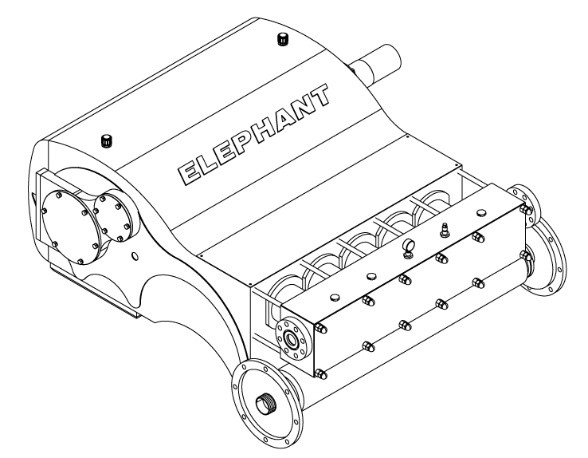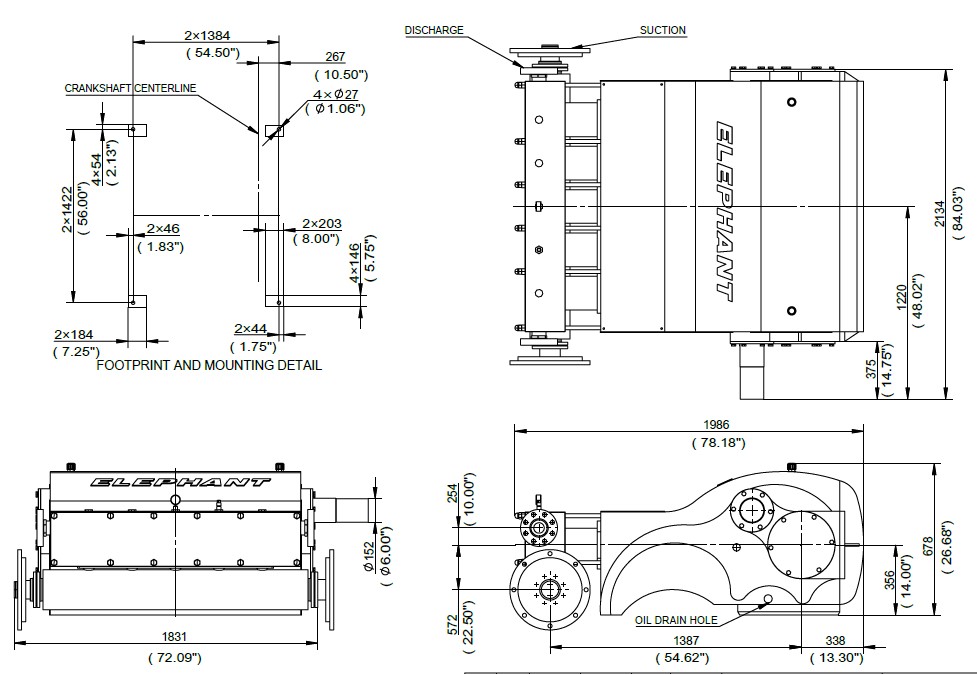Model :
DW-1000Type :
Plunger PumpStroke :
8.0 Inches / 203.2 mmCylinder Diameter :
44-159mmFlow :
159-6033.3LPM/42-1594GPMPressure :
7-69MPaShipping Port :
Shanghai Port, ChinaWarranty :
12 MonthsSpecifications:
| Design Standard | API-674,Third Edition |
| Configuration | Horizontal quintuple Plunger |
| Number of Plungers | 5 |
| Continuous Duty | 700 BHP |
| Intermittent Duty | 1000 BHP |
| Stroke Length | 8.0 Inches / 203.2 mm |
| Frame Load Rating | 30,000 lbs / 13608 kg |
| Pump Weight (Average) | 13,000 lbs / 5896.8 kg |
| Intermittent Duty Speed Rating | 300 RPM |
| Continuous Duty Speed Rating | 210 RPM |
| Minimum Speed | 100 RPM |
| Mechanical Efficiency | 90% |
| Lubrication System | Splash, Gravity Return |
| Lubrication System (Optional) | Pressurized |
| Crankcase Oil Capacity | 38 Gallons / 143.83 L |
| Lube Oil Type | SAE30 |
| Fluid Temperature Range | -20~350°F/-28~176°C |
| Valve Type | Disc Valve / Wear-resistant Valve |
Performance Data (Metric):
| Pump Model |
Plunger Diameter (mm) |
Displacement (L/REV) |
Maximum Pressure (MPa) |
Pump Capacity (LPM)@Input Speed (RPM) | |||||
| 100 | 150 | 200 | 210 | 250 | 300 | ||||
| DW100014 | 44 | 1.5765 | 69 | 159.0 | 234.7 | 314.2 | 329.3 | 393.6 | 473.1 |
| DW100016 | 51 | 2.0590 | 66 | 204.4 | 310.4 | 412.6 | 431.5 | 514.8 | 617.0 |
| DW100018 | 57 | 2.6060 | 52 | 261.2 | 389.9 | 522.3 | 548.8 | 651.0 | 783.5 |
| DW100020 | 64 | 3.2173 | 42 | 321.7 | 484.5 | 643.5 | 677.5 | 806.2 | 965.2 |
| DW100022 | 70 | 3.8929 | 35 | 389.9 | 582.9 | 779.7 | 817.6 | 972.7 | 1169.6 |
| DW100024 | 76 | 4.6328 | 29 | 461.8 | 696.4 | 927.3 | 972.7 | 1158.2 | 1389.1 |
| DW100026 | 83 | 5.4372 | 25 | 545.0 | 813.8 | 1086.3 | 1143.1 | 1358.8 | 1631.3 |
| DW100027 | 86 | 5.8633 | 23 | 586.7 | 881.9 | 1173.4 | 1230.1 | 1464.8 | 1760.0 |
| DW100028 | 89 | 6.3058 | 22 | 632.1 | 946.3 | 1260.4 | 1324.8 | 1578.3 | 1892.5 |
| DW100030 | 95 | 7.2388 | 19 | 722.9 | 1086.3 | 1449.7 | 1521.6 | 1809.2 | 2172.6 |
| DW100032 | 102 | 8.2362 | 16 | 825.1 | 1233.9 | 1646.5 | 1729.7 | 2059.0 | 2471.6 |
| DW100034 | 108 | 9.2979 | 15 | 931.1 | 1392.9 | 1858.4 | 1953.1 | 2324.0 | 2789.5 |
| DW100036 | 114 | 10.4239 | 13 | 1040.9 | 1563.2 | 2085.5 | 2187.7 | 2607.9 | 3126.4 |
| DW100037 | 117 | 11.0109 | 12 | 1101.4 | 1650.3 | 2199.1 | 2308.9 | 2751.7 | 3304.3 |
| DW100038 | 121 | 11.6143 | 12 | 1162.0 | 1741.1 | 2324.0 | 2437.5 | 2903.1 | 3486.0 |
| DW100040 | 127 | 12.8690 | 11 | 1286.9 | 1930.4 | 2573.8 | 2702.5 | 3217.3 | 3860.7 |
| DW100042 | 133 | 14.1881 | 10 | 1419.4 | 2127.2 | 2838.8 | 2978.8 | 3546.5 | 4258.1 |
| DW100044 | 140 | 15.5715 | 9 | 1555.6 | 2335.3 | 3115.1 | 3270.2 | 3894.8 | 4670.7 |
| DW100046 | 146 | 17.0193 | 8 | 1703.3 | 2551.1 | 3402.7 | 3573.0 | 4254.3 | 5106.0 |
| DW100048 | 152 | 18.5314 | 7 | 1854.7 | 2778.2 | 3705.5 | 3891.0 | 4632.8 | 5560.2 |
| DW100050 | 159 | 20.1078 | 7 | 2009.8 | 3016.6 | 4023.5 | 4224.1 | 5026.5 | 6033.3 |
Performance Data:
| Pump Model |
Plunger Diameter (in) |
Displacement (GAL/REV) |
Maximum Pressure (PSI) |
Pump Capacity (GPM)@Input Speed (RPM) | |||||
| 100 | 150 | 200 | 210 | 250 | 300 | ||||
| DW100014 | 1.75 | 0.4165 | 10000 | 42 | 62 | 83 | 87 | 104 | 125 |
| DW100016 | 2 | 0.544 | 9550 | 54 | 82 | 109 | 114 | 136 | 163 |
| DW100018 | 2.25 | 0.6885 | 7500 | 69 | 103 | 138 | 145 | 172 | 207 |
| DW100020 | 2.5 | 0.85 | 6125 | 85 | 128 | 170 | 179 | 213 | 255 |
| DW100022 | 2.75 | 1.0285 | 5025 | 103 | 154 | 206 | 216 | 257 | 309 |
| DW100024 | 3 | 1.224 | 4250 | 122 | 184 | 245 | 257 | 306 | 367 |
| DW100026 | 3.25 | 1.4365 | 3620 | 144 | 215 | 287 | 302 | 359 | 431 |
| DW100027 | 3.375 | 1.5491 | 3355 | 155 | 233 | 310 | 325 | 387 | 465 |
| DW100028 | 3.5 | 1.666 | 3125 | 167 | 250 | 333 | 350 | 417 | 500 |
| DW100030 | 3.75 | 1.9125 | 2720 | 191 | 287 | 383 | 402 | 478 | 574 |
| DW100032 | 4 | 2.176 | 2390 | 218 | 326 | 435 | 457 | 544 | 653 |
| DW100034 | 4.25 | 2.4565 | 2110 | 246 | 368 | 491 | 516 | 614 | 737 |
| DW100036 | 4.5 | 2.754 | 1890 | 275 | 413 | 551 | 578 | 689 | 826 |
| DW100037 | 4.625 | 2.9091 | 1790 | 291 | 436 | 581 | 610 | 727 | 873 |
| DW100038 | 4.75 | 3.0685 | 1690 | 307 | 460 | 614 | 644 | 767 | 921 |
| DW100040 | 5 | 3.4 | 1530 | 340 | 510 | 680 | 714 | 850 | 1020 |
| DW100042 | 5.25 | 3.7485 | 1390 | 375 | 562 | 750 | 787 | 937 | 1125 |
| DW100044 | 5.5 | 4.114 | 1260 | 411 | 617 | 823 | 864 | 1029 | 1234 |
| DW100046 | 5.75 | 4.4965 | 1160 | 450 | 674 | 899 | 944 | 1124 | 1349 |
| DW100048 | 6 | 4.896 | 1060 | 490 | 734 | 979 | 1028 | 1224 | 1469 |
| DW100050 | 6.25 | 5.3125 | 980 | 531 | 797 | 1063 | 1116 | 1328 | 1594 |
Standard connection sizes:
| Pump Model | Suction (in) | Discharge(in) |
| DW100014-DW100020 | 4.0 | 3.0 |
| DW100014-DW100024 | 6.0 | 3.0 |
| DW100026-DW100034 | 8.0 | 4.0 |
| DW100036-DW100040 | 10.0 | 6.0 |
| DW100042-DW100050 | 12.0 | 6.0 |
Fluid cylinder materials:
| Fluid cylinder materials | Cast |
| Carbon Steel | N/A |
| Hi-Strength Carbon Alloy Steel | |
| 304 / 316L / 17-4PH / 2205 / 2507 Stainless Steel |
*Special materials are available upon request


Engineering dimensional outline


FAQ
1. What causes increased noise during chemical injection pump operation?
This may result from wear or loosening of internal pump components. For example, piston rings, bearings, or other moving parts may wear out after prolonged use, leading to noise generation. Additionally, unstable pump foundations or loose connections may generate extra vibration and noise. Air or bubbles in the medium can also exacerbate operational noise issues. To address this, inspect and replace worn components, ensure the mounting base is secure, and perform proper degassing of the medium to minimize noise sources.
2. How can the service life of chemical injection pumps be extended?
Regular maintenance is crucial for extending the service life of chemical injection pumps. First, establish a systematic maintenance schedule that includes periodic cleaning of the pump body, inspection of seals and valves, and lubrication of moving parts. Second, avoid prolonged operation under overload conditions by scheduling appropriate work cycles and rest periods to minimize mechanical fatigue. Additionally, operators should undergo professional training and strictly adhere to operating procedures to prevent damage from misoperation. For wear-prone components like seals and pistons, maintain an adequate stock of spare parts and replace them promptly based on actual usage. Simultaneously, deploy intelligent monitoring systems to track equipment status in real time, enabling early detection of potential issues and proactive measures to prevent sudden failures from damaging the equipment. These comprehensive approaches significantly enhance the reliability and durability of chemical injection pumps.
3. How can pump body damage be prevented when handling highly corrosive media?
Selecting appropriate materials is crucial for preventing pump body damage. For highly corrosive media, use corrosion-resistant alloys or specially coated materials that maintain stability in harsh environments. Additionally, optimizing the internal structure design to minimize contact between the medium and the pump body effectively reduces corrosion risks. During routine maintenance, enhancing anti-corrosion measures—such as regularly inspecting the pump body surface for corrosion signs and promptly repairing any damage—can further extend equipment lifespan. Simultaneously, employing advanced sealing technology ensures the medium does not leak outside the pump body, thereby preventing harm to the environment and operators. These methods significantly enhance the safety and reliability of chemical injection pumps when handling highly corrosive media.
4. How should abnormal shutdowns be addressed?
First, immediately inspect the equipment's power supply and control systems to confirm no external factors caused power loss or control signal interruption. Next, examine the pump interior for blockages or solidified media, which may increase operational resistance and trigger shutdowns. Simultaneously, check critical components like seals, valves, and pipe connections for damage or leaks, as these issues can also disrupt normal operation. If no issues are identified through the above checks, further analysis of data recorded by the intelligent monitoring system is required. Identify potential fault points by examining changes in operating parameters and implement corresponding adjustments or repairs. To prevent recurrence, train operators to enhance their ability to recognize and address equipment abnormalities. Additionally, optimize the equipment's preventive maintenance plan to ensure long-term stable operation.
